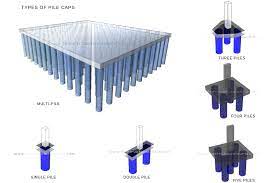Footing and pile cap are two essential components of structural foundations that serve distinct purposes in transferring loads from a structure to the underlying soil or rock. Let’s explore the differences between footings and pile caps:
Footing:
- Purpose: Footings are designed to distribute the load of a structure over a larger area to prevent excessive settlement and ensure stability.
- Application: Footings are used to support load-bearing walls, columns, and other structural elements.
- Types: Strip footings, isolated footings, combined footings, and mat footings (raft foundations) are common types of footings, each suited for specific load conditions and soil characteristics.
- Design: Footings are designed based on factors such as soil bearing capacity, structural loadings, and building codes. The design ensures that the footing’s width, depth, and reinforcement are adequate for load distribution.
- Construction: Footings are typically constructed by excavating the soil, compacting it, placing reinforcement, and pouring concrete into the prepared trench or formwork. Curing and proper inspection are vital during the construction process.
Pile Cap:
- Purpose: Pile caps serve as a connection between the piles and the structure above. Distributing the load from the structure to a group of piles.
- Application: Pile caps are used when the soil conditions are inadequate for spreading loads over a larger area or when dealing with heavy loads, dynamic loads, or lateral forces.
- Design: Pile caps are designed to accommodate the arrangement, spacing, and capacity of the piles. The design considers load distribution, structural requirements, soil conditions, and building codes.
- Construction: Pile caps are typically constructed by installing piles into the ground and then excavating and forming a concrete mat around the pile heads. Reinforcement is placed within the formwork, and concrete is poured and cured. Load testing may be conducted to verify performance. Footing and pile cap
Key Differences:
- Load Distribution: Footings distribute loads over a wider area, while pile caps transfer loads to a group of piles.
- Application: Footings support individual structural elements. While pile caps are used with piles to support heavier loads or challenging soil conditions.
- Design Approach: Footings are designed based on soil bearing capacity and structural loads. While pile caps consider pile configuration, load distribution, and soil conditions.
- Construction Process: Footings are typically excavated trenches, whereas pile caps involve pile installation and excavation around the pile heads.
In summary, footings distribute loads over a larger area, while pile caps transfer loads to piles. The choice between footings and pile caps depends on factors such as soil conditions, structural loads, and project requirements. Consulting with a professional engineer or structural designer is crucial to ensure the appropriate foundation system is chosen and designed for the specific project.

